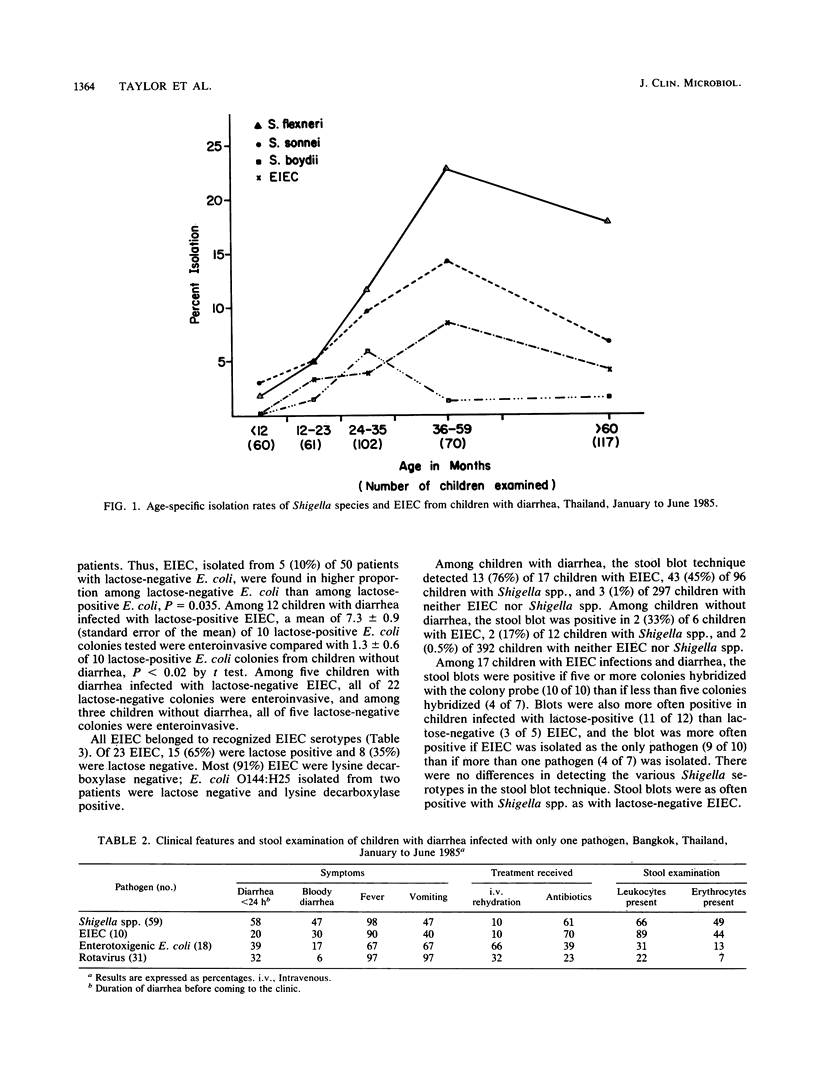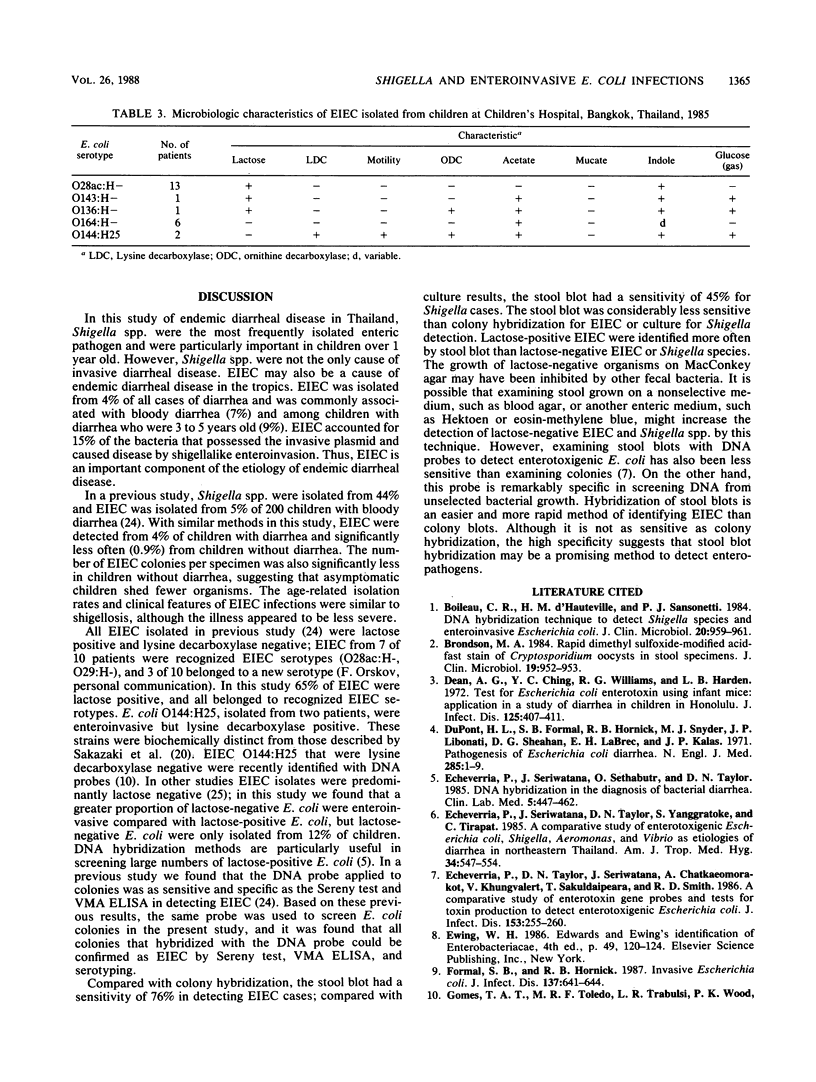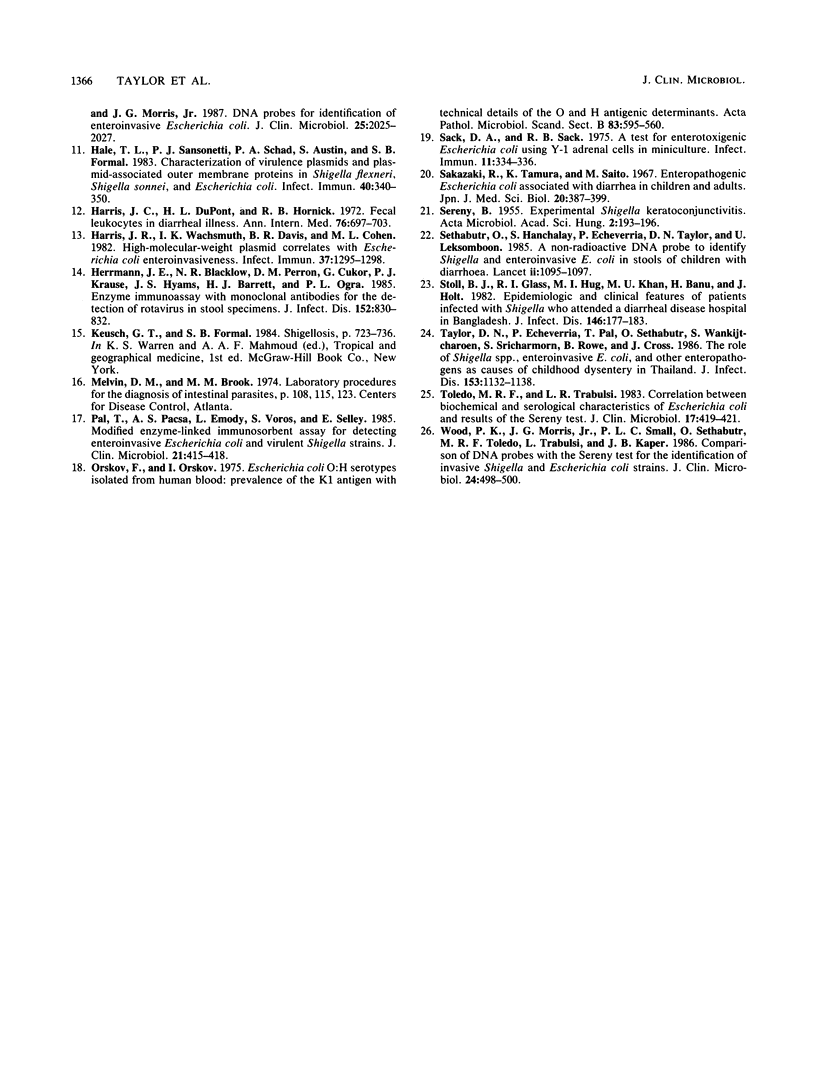Abstract
To determine the clinical and microbiologic features of Shigella and enteroinvasive Escherichia coli (EIEC) infections, we investigated 410 children with diarrhea and 410 control children without diarrhea who were seen at Children's Hospital, Bangkok, Thailand, from January to June 1985. Shigella spp. were isolated from 96 (23%) and EIEC were isolated from 17 (4%) of 410 children with diarrhea and from 12 (3%) and 6 (1%) of 410 control children, respectively. The isolation rates of both pathogens increased with age and peaked in children 3 to 5 years old from whom Shigella spp. were isolated from 38% and EIEC were isolated from 9%. Shigella spp. were isolated from 52% and EIEC were isolated from 7% of 91 children with bloody diarrhea and from 15 and 3% of 319 children with nonbloody diarrhea. Fifteen (65%) of 23 EIEC were lactose positive, and all belonged to recognized EIEC serotypes. Among children with diarrhea, the stool blots of 76% of 17 children infected with EIEC, 45% of 96 children infected with Shigella spp., and 1% of 297 culture-negative children hybridized with the 17-kilobase EcoRI digestion fragment of pRM17, a recombinant plasmid containing DNA derived from the 140-megadalton Shigella flexneri plasmid. Although EIEC colonies can be reliably detected by DNA hybridization, detection by stool blot is less sensitive. Shigella spp. and EIEC are important causes of endemic diarrhea among children greater than 1 year old in Thailand.
Full text
PDF




Selected References
These references are in PubMed. This may not be the complete list of references from this article.
- Boileau C. R., d'Hauteville H. M., Sansonetti P. J. DNA hybridization technique to detect Shigella species and enteroinvasive escherichia coli. J Clin Microbiol. 1984 Nov;20(5):959–961. doi: 10.1128/jcm.20.5.959-961.1984. [DOI] [PMC free article] [PubMed] [Google Scholar]
- Bronsdon M. A. Rapid dimethyl sulfoxide-modified acid-fast stain of Cryptosporidium oocysts in stool specimens. J Clin Microbiol. 1984 Jun;19(6):952–953. doi: 10.1128/jcm.19.6.952-953.1984. [DOI] [PMC free article] [PubMed] [Google Scholar]
- Dean A. G., Ching Y. C., Williams R. G., Harden L. B. Test for Escherichia coli enterotoxin using infant mice: application in a study of diarrhea in children in Honolulu. J Infect Dis. 1972 Apr;125(4):407–411. doi: 10.1093/infdis/125.4.407. [DOI] [PubMed] [Google Scholar]
- DuPont H. L., Formal S. B., Hornick R. B., Snyder M. J., Libonati J. P., Sheahan D. G., LaBrec E. H., Kalas J. P. Pathogenesis of Escherichia coli diarrhea. N Engl J Med. 1971 Jul 1;285(1):1–9. doi: 10.1056/NEJM197107012850101. [DOI] [PubMed] [Google Scholar]
- Echeverria P., Seriwatana J., Sethabutr O., Taylor D. N. DNA hybridization in the diagnosis of bacterial diarrhea. Clin Lab Med. 1985 Sep;5(3):447–462. [PubMed] [Google Scholar]
- Echeverria P., Seriwatana J., Taylor D. N., Yanggratoke S., Tirapat C. A comparative study of enterotoxigenic Escherichia coli, Shigella, Aeromonas, and Vibrio as etiologies of diarrhea in northeastern Thailand. Am J Trop Med Hyg. 1985 May;34(3):547–554. doi: 10.4269/ajtmh.1985.34.547. [DOI] [PubMed] [Google Scholar]
- Echeverria P., Taylor D. N., Seriwatana J., Chatkaeomorakot A., Khungvalert V., Sakuldaipeara T., Smith R. D. A comparative study of enterotoxin gene probes and tests for toxin production to detect enterotoxigenic Escherichia coli. J Infect Dis. 1986 Feb;153(2):255–260. doi: 10.1093/infdis/153.2.255. [DOI] [PubMed] [Google Scholar]
- Formal S. B., Hornick R. B. Invasive Escherichia coli. J Infect Dis. 1978 May;137(5):641–644. doi: 10.1093/infdis/137.5.641. [DOI] [PubMed] [Google Scholar]
- Gomes T. A., Toledo M. R., Trabulsi L. R., Wood P. K., Morris J. G., Jr DNA probes for identification of enteroinvasive Escherichia coli. J Clin Microbiol. 1987 Oct;25(10):2025–2027. doi: 10.1128/jcm.25.10.2025-2027.1987. [DOI] [PMC free article] [PubMed] [Google Scholar]
- Hale T. L., Sansonetti P. J., Schad P. A., Austin S., Formal S. B. Characterization of virulence plasmids and plasmid-associated outer membrane proteins in Shigella flexneri, Shigella sonnei, and Escherichia coli. Infect Immun. 1983 Apr;40(1):340–350. doi: 10.1128/iai.40.1.340-350.1983. [DOI] [PMC free article] [PubMed] [Google Scholar]
- Harris J. C., Dupont H. L., Hornick R. B. Fecal leukocytes in diarrheal illness. Ann Intern Med. 1972 May;76(5):697–703. doi: 10.7326/0003-4819-76-5-697. [DOI] [PubMed] [Google Scholar]
- Harris J. R., Wachsmuth I. K., Davis B. R., Cohen M. L. High-molecular-weight plasmid correlates with Escherichia coli enteroinvasiveness. Infect Immun. 1982 Sep;37(3):1295–1298. doi: 10.1128/iai.37.3.1295-1298.1982. [DOI] [PMC free article] [PubMed] [Google Scholar]
- Herrmann J. E., Blacklow N. R., Perron D. M., Cukor G., Krause P. J., Hyams J. S., Barrett H. J., Ogra P. L. Enzyme immunoassay with monoclonal antibodies for the detection of rotavirus in stool specimens. J Infect Dis. 1985 Oct;152(4):830–832. doi: 10.1093/infdis/152.4.830. [DOI] [PubMed] [Google Scholar]
- Orskov F., Orskov I. Escherichia coli O:H serotypes isolated from human blood. Prevalence of the K1 antigen with technical details of O and H antigenic determination. Acta Pathol Microbiol Scand Suppl. 1975 Dec;83(6):595–600. [PubMed] [Google Scholar]
- Pál T., Pácsa A. S., Emödy L., Vörös S., Sélley E. Modified enzyme-linked immunosorbent assay for detecting enteroinvasive Escherichia coli and virulent Shigella strains. J Clin Microbiol. 1985 Mar;21(3):415–418. doi: 10.1128/jcm.21.3.415-418.1985. [DOI] [PMC free article] [PubMed] [Google Scholar]
- Sack D. A., Sack R. B. Test for enterotoxigenic Escherichia coli using Y-1 adrenal cells in miniculture. Infect Immun. 1975 Feb;11(2):334–336. doi: 10.1128/iai.11.2.334-336.1975. [DOI] [PMC free article] [PubMed] [Google Scholar]
- Sakazaki R., Tamura K., Saito M. Enteropathogenic Escherichia coli associated with diarrhea in children and adults. Jpn J Med Sci Biol. 1967 Oct;20(5):387–399. doi: 10.7883/yoken1952.20.387. [DOI] [PubMed] [Google Scholar]
- Sethabutr O., Hanchalay S., Echeverria P., Taylor D. N., Leksomboon U. A non-radioactive DNA probe to identify Shigella and enteroinvasive Escherichia coli in stools of children with diarrhoea. Lancet. 1985 Nov 16;2(8464):1095–1097. doi: 10.1016/s0140-6736(85)90687-7. [DOI] [PubMed] [Google Scholar]
- Stoll B. J., Glass R. I., Huq M. I., Khan M. U., Banu H., Holt J. Epidemiologic and clinical features of patients infected with Shigella who attended a diarrheal disease hospital in Bangladesh. J Infect Dis. 1982 Aug;146(2):177–183. doi: 10.1093/infdis/146.2.177. [DOI] [PubMed] [Google Scholar]
- Taylor D. N., Echeverria P., Pál T., Sethabutr O., Saiborisuth S., Sricharmorn S., Rowe B., Cross J. The role of Shigella spp., enteroinvasive Escherichia coli, and other enteropathogens as causes of childhood dysentery in Thailand. J Infect Dis. 1986 Jun;153(6):1132–1138. doi: 10.1093/infdis/153.6.1132. [DOI] [PubMed] [Google Scholar]
- Toledo M. R., Trabulsi L. R. Correlation between biochemical and serological characteristics of Escherichia coli and results of the Serény test. J Clin Microbiol. 1983 Mar;17(3):419–421. doi: 10.1128/jcm.17.3.419-421.1983. [DOI] [PMC free article] [PubMed] [Google Scholar]
- Wood P. K., Morris J. G., Jr, Small P. L., Sethabutr O., Toledo M. R., Trabulsi L., Kaper J. B. Comparison of DNA probes and the Sereny test for identification of invasive Shigella and Escherichia coli strains. J Clin Microbiol. 1986 Sep;24(3):498–500. doi: 10.1128/jcm.24.3.498-500.1986. [DOI] [PMC free article] [PubMed] [Google Scholar]


